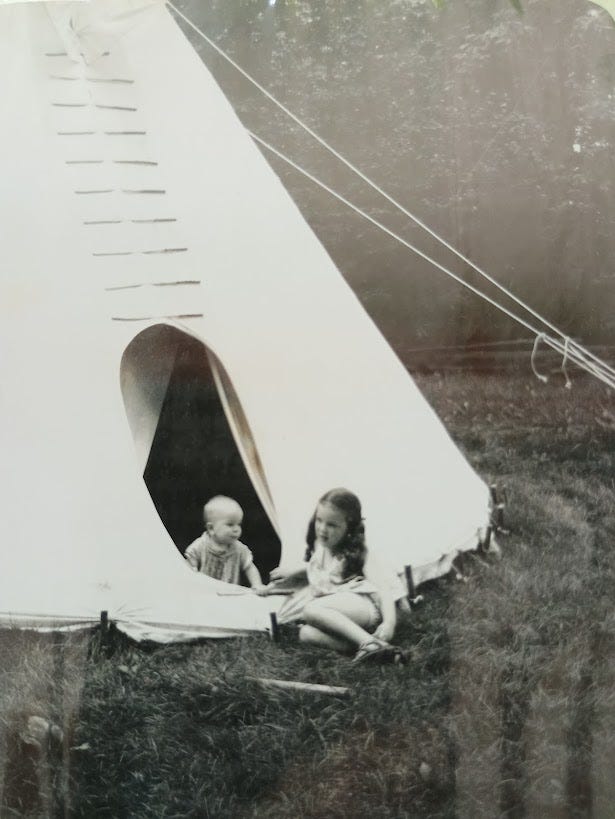How to make a Sioux tipi
Portable home - store in a weather-proof place to be ready for a quick new home after a disaster strikes... pack it on your Noah's Ark.
“The old-time tipi was a temple as well as a home. The floor of the tipi represented the earth on which we live, the walls of the tipi the sky, and the poles the trails from earth to the spirit world—the links between man and Wakan’ Tanka, the Great Mystery.
Directly behind the fireplace was a little space of bare earth which served as a family altar. Often this space was prepared in the shape of a square, the sod and all roots and stubs removed, and the earth within the square pulverised and brushed clean. The Sioux called this altar a “square of mellowed earth.” It represented Mother Earth, and on this square sweet grass, cedar, or sage were burned as incense to the spirits. The type of incense used on a given occasion depended on the ceremony as well as what was available, but the burning of incense was an important part of every ceremony. It carried prayers to the Ones Above, as did the smoke from a pipe. Indeed, the pipe itself was often purified in the smoke of incense.
Before a meal the host said a grace and made an offering of choice piece of meat, either by placing it in the fire, or burying it in the earth on the altar.” (The Indian Tipi, Laubin and Laubin, 1957, page 91)
Read more at Internet Archive or an updated edition that contains more recipes and daily life of indigenous Americans The Indian Tipi by Reginald Laubin | Open Library; and a 1977 version can be accessed at Anna’s Archive: The Indian Tipi: Its History, Construction, and Use, 2nd Edition - Anna’s Archive.
*The Noah’s Ark post.
‘The Indian Tipi’ is a useful book full of many types/tribal tipi patterns and images and history and lore about the decorations inside, and exterior examples of ‘painted tipis’ which was often used as a memorial. Used copies of the 1957 edition are selling for ~ $20.
This pattern which follows is from the book ‘The Indian Tipi - Its History, Construction, and Use’ by Reginald Laubin, Gladys Laubin; To Buy: Near Fine Hardcover (1957) First Edition | J. F. Whyland Books)
“There is only beauty behind me,
Only beauty is before me!”
—Cree Song, (page 2)
The diameter of the tipi at the base determines how tall the poles need to be and how spacious the interior will be. Twelve-foot diameter tipis might be useful for a single person and were used on hunting trips and would weigh less for transport, needing fewer horses. And smaller and lighter poles would be easier to put up and take down without an extra person. A twelve foot diameter tipi requires ~ 15-foot-long poles and fewer than needed for a larger diameter tipi. Smaller interiors might be easier to heat in cold winter months. Tribal preferences varied regarding height to diameter and tended to tip the tipi slightly forward (see pages 19 and 27).
A shallow drainage ditch was dug around a tipi for long term encampments to reduce flooding and a channel would be dug to direct the ‘moat’ water farther away. Permanent encampments might have large lodges of 23 to 30 foot diameter with poles of 27 to 40 feet long. (page 19)
Gender differences are real. Men would call their home tipi ‘mine’, yet tipis and the poles were work completed by females and putting up and taking down the tipi would also typically be done by females of a family. Males would take care of their tipi on a hunting trip. (page 33) Males and females had distinct seating arrangements within the tipi based on seniority as well as gender and politeness customs were followed along with kinship terms (father/grandfather/brother/cousin depending on age and closeness of the aquaintence, even if unrelated. ‘Locking’ a tipi when away or wanting privacy was as simple as placing to crossed sticks over a closed door flap, otherwise doorways were typically left open during the day. (page 91)
The image is of a tipi my parents made based on the pattern from the book and is a family size, 16-foot diameter I think. In the image below the ‘zipper’ effect is small sticks securing the two sides of the tipi cover together by sliding each stick through button-hole type opening in each side.

It is an interesting book with a few places to read online. My copy of the book is damaged so I scanned it.
Read more at Internet Archive (1957 version, a few pages are scanned above)
or an updated edition that contains more recipes and daily life of indigenous Americans The Indian Tipi by Reginald Laubin | Open Library;
and a 1977 version can be accessed at Anna’s Archive: The Indian Tipi: Its History, Construction, and Use, 2nd Edition - Anna’s Archive.
Disclaimer: This information is being provided for educational purposes within the guidelines of Fair Use and is not intended to provide individual health care guidance, but sleeping on the ground and sitting on the ground (‘grounding’ in modern lingo) may be supportive of health as it aligns our energy with Earth’s rhythm and may help balance inflammatory ions.










We did a lot of camping when I was a child, but not in a tipi! That’s pretty cool your parents made one for your camping trips Jennifer. Thanks for the interesting ideas! 🙏